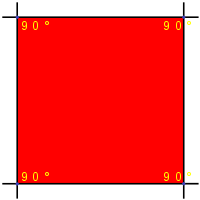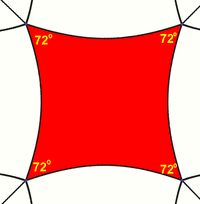Square: Difference between revisions
*ㅁ |
|||
| Line 30: | Line 30: | ||
:<math>A=t^2.\,</math> |
:<math>A=t^2.\,</math> |
||
In classical times, the second power was described in terms of the area of a square, as in the above formula. This led to the use of the term ''[[Square (algebra)|square]]'' to mean raising to the second power. |
is not a TRIANGLE!!!! In classical times, the second power was described in terms of the area of a square, as in the above formula. This led to the use of the term ''[[Square (algebra)|square]]'' to mean raising to the second power. |
||
== Standard coordinates == |
== Standard coordinates == |
||
Revision as of 14:43, 23 November 2009
| Square | |
|---|---|
 A square is a regular quadrilateral. | |
| Edges and vertices | 4 |
| Schläfli symbol | {4} |
| Coxeter–Dynkin diagrams | |
| Symmetry group | Dihedral (D4) |
| Area (with t=edge length) |
t2 |
| Internal angle (degrees) |
90° |
| Properties | convex, cyclic, equilateral, isogonal, isotoxal |
In geometry, a square is a regular quadrilateral. This means that it has four equal sides and four equal angles (90 degree angles, or right angles). A square with vertices ABCD would be denoted ABCD.
Perimeter and area

The perimeter of a square whose sides have length t is
and the area is
is not a TRIANGLE!!!! In classical times, the second power was described in terms of the area of a square, as in the above formula. This led to the use of the term square to mean raising to the second power.
Standard coordinates
The coordinates for the vertices of a square centered at the origin and with side length 2 are (±1, ±1), while the interior of the same consists of all points (x0, x1) with −1 < xi < 1.
Equations
The equation max describes a square. This means " or , whichever is larger, equals 1." The circumradius of this square is .
Properties
A square is both a rhombus (equal sides) and a rectangle (equal angles) and therefore has all the properties of both these shapes, namely:
- The diagonals of a square bisect each other.
- The diagonals of a square bisect its angles.
- The diagonals of a square are perpendicular.
- Opposite sides of a square are both parallel and equal.
- All four angles of a square are equal. (Each is 360/4 = 90 degrees, so every angle of a square is a right angle.)
- The diagonals of a square are equal.
Other facts
- If the diagonals of a rhombus are equal, then that rhombus must be a square. The diagonals of a square are (about 1.414) times the length of a side of the square. This value, known as Pythagoras’ constant, was the first number proven to be irrational.
- A square can also be defined as a rectangle with all sides equal, or a rhombus with all angles equal, or a parallelogram with equal diagonals that bisect the angles.
- If a figure is both a rectangle (right angles) and a rhombus (equal edge lengths), then it is a square. (Rectangle (four equal angles) + Rhombus (four equal sides) = Square)
- If a circle is circumscribed around a square, the area of the circle is (about 1.57) times the area of the square.
- If a circle is inscribed in the square, the area of the circle is (about 0.79) times the area of the square.
- A square has a larger area than any other quadrilateral with the same perimeter ([1]).
- A square tiling is one of three regular tilings of the plane (the others are the equilateral triangle and the regular hexagon).
- The square is in two families of polytopes in two dimensions: hypercube and the cross polytope. The Schläfli symbol for the square is {4}.
- The square is a highly symmetric object (in Goldman geometry). There are four lines of reflectional symmetry and it has rotational symmetry through 90°, 180° and 270°. Its symmetry group is the dihedral group D4.
Non-Euclidean geometry
In non-euclidean geometry, squares are more generally polygons with 4 equal sides and equal angles.
In spherical geometry, a square is a polygon whose edges are great circle arcs of equal distance, which meet at equal angles. Unlike the square of plane geometry, the angles of such a square are larger than a right angle.
In hyperbolic geometry, squares with right angles do not exist. Rather, squares in hyperbolic geometry have angles of less than right angles. Larger squares have smaller angles.
Examples:
 Six squares can tile the sphere with 3 squares around each vertex and 120 degree internal angles. This is called a spherical cube. The Schläfli symbol is {4,3}. |
 Squares can tile the Euclidean plane with 4 around each vertex, with each square having an internal angle of 90 degrees. The Schläfli symbol is {4,4}. |
 Squares can tile the hyperbolic plane with 5 around each vertex, with each square having 72 degree internal angles. The Schläfli symbol is {4,5}. |
See also
- Cube
- Pythagorean theorem
- Square lattice
- Unit square
- Squircle
- Hypercubes family
- Point (geometry) - -
- Line (geometry) - {}
- Square - {4}
- Cube - {4,3}
- Tesseract - {4,3,3}
- Penteract - {4,3,3,3}
- Hexeract - {4,3,3,3,3}
- Hepteract - {4,3,3,3,3,3}
- Octeract - {4,3,3,3,3,3,3}
- Enneract - {4,3,3,3,3,3,3,3}
- Dekeract - {4,3,3,3,3,3,3,3,3}
- Hendekeract - {4,3,3,3,3,3,3,3,3,3}
- Dodekeract - {4,3,3,3,3,3,3,3,3,3,3}
- n-eract
- ㅁ









